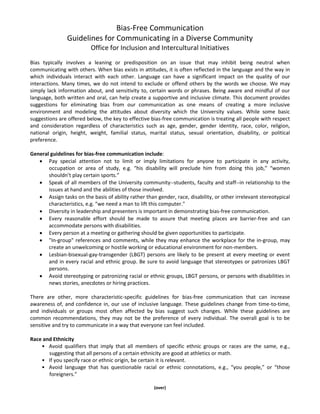
Bias-Free_Communication_2009
- 1. Bias-Free Communication Guidelines for Communicating in a Diverse Community Office for Inclusion and Intercultural Initiatives Bias typically involves a leaning or predisposition on an issue that may inhibit being neutral when communicating with others. When bias exists in attitudes, it is often reflected in the language and the way in which individuals interact with each other. Language can have a significant impact on the quality of our interactions. Many times, we do not intend to exclude or offend others by the words we choose. We may simply lack information about, and sensitivity to, certain words or phrases. Being aware and mindful of our language, both written and oral, can help create a supportive and inclusive climate. This document provides suggestions for eliminating bias from our communication as one means of creating a more inclusive environment and modeling the attitudes about diversity which the University values. While some basic suggestions are offered below, the key to effective bias-free communication is treating all people with respect and consideration regardless of characteristics such as age, gender, gender identity, race, color, religion, national origin, height, weight, familial status, marital status, sexual orientation, disability, or political preference. General guidelines for bias-free communication include: Pay special attention not to limit or imply limitations for anyone to participate in any activity, occupation or area of study, e.g. "his disability will preclude him from doing this job,” “women shouldn’t play certain sports.” Speak of all members of the University community--students, faculty and staff--in relationship to the issues at hand and the abilities of those involved. Assign tasks on the basis of ability rather than gender, race, disability, or other irrelevant stereotypical characteristics, e.g. "we need a man to lift this computer." Diversity in leadership and presenters is important in demonstrating bias-free communication. Every reasonable effort should be made to assure that meeting places are barrier-free and can accommodate persons with disabilities. Every person at a meeting or gathering should be given opportunities to participate. "In-group" references and comments, while they may enhance the workplace for the in-group, may create an unwelcoming or hostile working or educational environment for non-members. Lesbian-bisexual-gay-transgender (LBGT) persons are likely to be present at every meeting or event and in every racial and ethnic group. Be sure to avoid language that stereotypes or patronizes LBGT persons. Avoid stereotyping or patronizing racial or ethnic groups, LBGT persons, or persons with disabilities in news stories, anecdotes or hiring practices. There are other, more characteristic-specific guidelines for bias-free communication that can increase awareness of, and confidence in, our use of inclusive language. These guidelines change from time-to-time, and individuals or groups most often affected by bias suggest such changes. While these guidelines are common recommendations, they may not be the preference of every individual. The overall goal is to be sensitive and try to communicate in a way that everyone can feel included. Race and Ethnicity • Avoid qualifiers that imply that all members of specific ethnic groups or races are the same, e.g., suggesting that all persons of a certain ethnicity are good at athletics or math. • If you specify race or ethnic origin, be certain it is relevant. • Avoid language that has questionable racial or ethnic connotations, e.g., “you people,” or “those foreigners.” (over)
- 2. Gender and Gender Identity • Use gender-neutral words/phrases in your language, e.g. journalist, fire fighter, chairperson. Avoid the use of "man" or "woman" in job titles. • Address both female and male perspectives with phrases like "employees and their spouses or partners." Use pronouns and references that include both genders instead of only male, e.g. "he/she" or "women/men." • Avoid describing men by profession and women by physical attributes. • Use "gender" rather than "sex" to differentiate between men and women. Ability Status • Use "person first" language, e.g., "person with a disability," "student with a disability." • Avoid using the term “disability” as an adjective, e.g. the disability community. • Avoid using adjectives as nouns, e.g. "the deaf, the blind, the disabled." Rather, use "people who are deaf.” • Plan for and provide alternate forms of communications at events and gathering. This might include having interpreters, providing written materials in print format or in Braille, or providing oral interpretation for all visual information. Sexual Orientation • Use "sexual orientation" rather than phrases like "the gay lifestyle" or "sexual preference." • Use the phrase "partner or spouse". • When discussing families, be inclusive of families that are headed by same gender partners or lesbian, bisexual, gay, or transgender single parents and recognize the presence of LBGT youth in families. • When using the terms "diversity" or "multicultural," and reference is made to specific groups, include lesbian-bi-gay-transgender persons in such statements. Age • Mention age only when it is relevant. • Permit people of all ages to speak for themselves rather than assuming you know what they want. • Avoid making inappropriate assumptions about people based on their age. Ending bias takes awareness, openness and practice. Many biased statements seem so natural and familiar that we are unaware of the discomfort they cause for others. Become conscious of your communication and what it may imply. For more information, please seek assistance by contacting the following offices: • Office for Inclusion and Intercultural Initiatives 353-3922 • Women's Resource Center 353-1635 • Resource Center for Persons with Disabilities 353-9642; TTY: 355-1293 • Multicultural Programs-Students 353-7745 • Lesbian/Bisexual/Gay/Transgender Resource Center 355-8286 Office for Inclusion and Intercultural Initiatives 101 Olds Hall Michigan State University East Lansing, MI 48824-1046 Voice/TTY: 517/353-3922 Fax: 517/353-2988 Web: http://www.inclusion.msu.edu E-mail: inclusion@msu.edu MSU is an Affirmative Action/Equal Opportunity Employer
